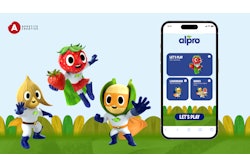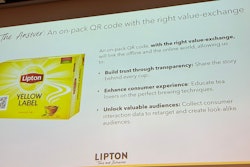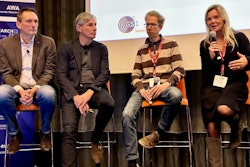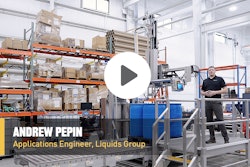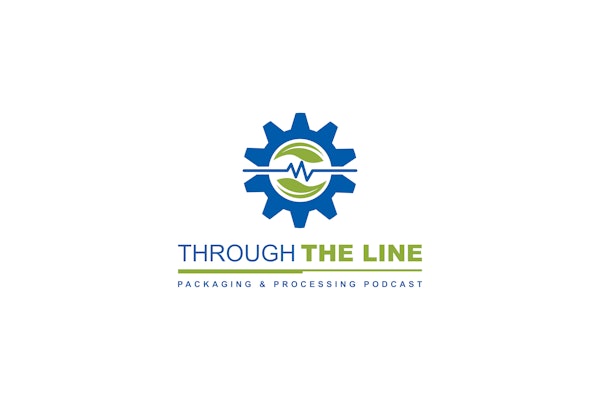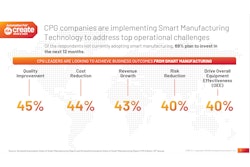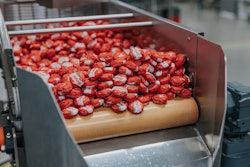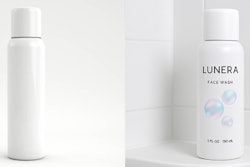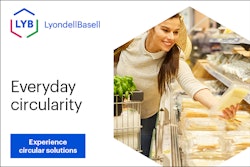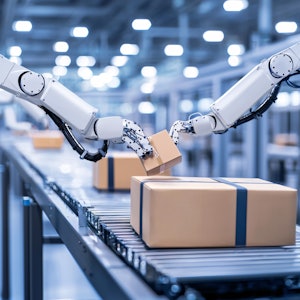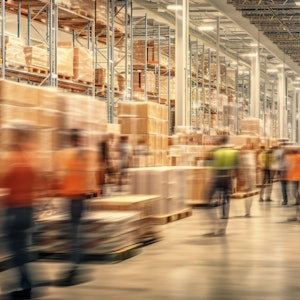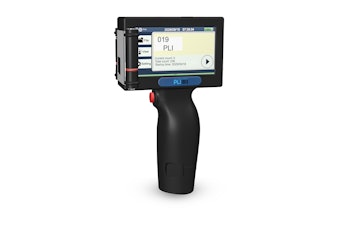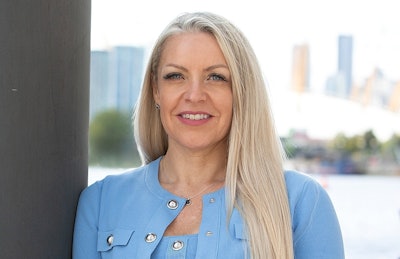
In an exclusive interview with Packaging World magazine, Jenny Stanley, the founder and managing director of creative technology studio Appetite Creative and author of the book, “Connected Packaging: The Game-Changing Marketing Tool,” explains why now is the time for brands to embrace on-pack digital technology.
Packaging World:
When did you recognize that packaging could become a media channel rather than just a “protective layer”?
Jenny Stanley:
It was quite some time ago, back in 2015, so basically 10 years ago, and we were working with Shazam [music identification app], and Shazam was doing a lot of scanning both on-pack, but also on their advertising. And when they were doing it on the physical pack, that’s when I thought, “Hang on a second, this actually has a lot of potential.” And we kind of moved into talking to a large packaging company, and that’s where it grew from, where we could see that what we were doing from digital advertising just translated so well into packaging—especially since it’s an opt-in media. Because the packaging is already in the hands of the consumer, it’s the most targeted media channel possible.
We’ve been talking about this technology for years, but there still aren’t a lot of commercial examples. Why is now a good time for brands to get involved with connected packaging?
I definitely agree with you. It’s not moved that quickly. As I said, I was talking about this in 2015, but I don’t think it really had its movement until COVID. And I think COVID then kind of said, “Hey look, this is what the QR code is, this is what it does.” And it really got it into the vernacular. So first, you needed the public to be able to understand what it [connected packaging] is to be able to have the numbers to make it worthwhile.
And then I think there are some other trends happening out there, like regulatory compliance. So there’s the EU digital product passport. Now that’s something where you must have something [a digital enabler], and the QR code is the easiest way to be able to deliver so much information, especially if you’ve got finite space on packaging. And there are the extended producer responsibility requirements as well. So again, this needs to be able to tell the consumers so much more when we don’t have any more space in the physical realm to be able to do that. So that’s number two.
Number three, there are now more and more examples in case settings of brands doing it well: We get a 14% scan rate, we get three-minute engagement time. You compare that to what you get from a digital ad, a 0.01 click-through rate, and that’s considered okay, if not good. There’s a huge difference there. That’s a big mover as well. Now people are starting to see, “Oh, this actually does work.” And also there’s an increase in sales. We want the general public to get involved. So it’s that kind of technology tipping point. It’s no longer experiential, it’s now becoming business critical.
 Appetite Creative
Appetite Creative
Which enabling technologies—QR codes, NFC tags, or RFID labels—are proving the most practical and scalable for CPG brands today?
QR codes are leading the charge. They’ve got the universal comfortability and cost effectiveness. We do a global survey every year. Eighty-eight percent of brands surveyed plan to use a QR code in 2025. QR codes don’t require any extra hardware anymore. They work across all the mobile smartphones. So that gives us that scalability, which is obviously necessary. But NFC was also rising up in the ranks, surprisingly so, and this is really a great technology for premium experiences. There is a balance of cost, functionality, and ROI. Obviously there is a cost for the NFC that the QR code doesn’t have. So if your product is retailing at £1.50, adding anything onto that cost is going to affect that margin. So when you start talking about products that are maybe over the £20 mark—more luxury—then NFC can really bring in some extra functionality.
How would you advise a CPG brand on which technology to use?
It depends on a number of things. What are your objectives? Who are your target audience? What’s your budget? QR codes are that broad base, that scalability, data connection, universal accessibility, cost effectiveness. But NFC would be your premium. Maybe you are an alcohol brand that costs £20 or £25, or whatever your currency is, and you can have a contactless experience. Again, does that work for your target audience? Determine what actually fits with what you’re trying to do, and make sure you’ve got the brand experience that works best.
What role do printing and production partners play in enabling connected packaging at scale?
They’re pretty crucial because of course you’ve got to be able to have that QR code integrated into the packaging design. We’ve got to maintain visual appeal. So it’s a balance. You can’t have a huge QR code slapped over the front of the product, the brand manager would go insane. But then, on the other side, you need to be able to make sure that the consumer finds an attractive code, that there is a call to action, that it is big enough, all of these different things. So there’s a balancing act that needs to be done there.
And then we have to think about technological or technical functionality across multiple devices, multiple formats. But then we also dive into perhaps serialization. There again, you need to have a printing partner who’s going to be able to support that. Is that something that they’re able to do? Because if not, then obviously that’s not going to work, and it’s going to need to be SKU- or product-based. And we’ve developed lots of different platforms that work across different regions, different languages, multiple designs. Some countries have different colors and branding and names and all of these different things. So it really has to work across all of these different kinds of formats and verticals.
So if I’m a CPG and I’m doing a promotion and I want to pilot a QR code, and I have package design just for that pilot or that promotion, would you say digital printing is the best way to go? How do I do produce that package at a small scale?
You’ve got multiple options open to you. One would be digital printing, of course. You can have a smaller batch, you can do a smaller run, or secondly work with some additional type of packaging. So is it going to be a neck tag or stickers, or is it something that you can work off that is an addition, a tie or something like that, to your packaging? And we’ve done quite a few of those. We actually did it with Dead Man’s Fingers, which is a rum brand from the U.K. We did stirrers and coasters. And for Bacardi, we also did straws a while back as well. So that was collaborating both on- and off-trade experiences as well. So there are a lot of different ways, if you can be creative, to do a smaller campaign.
One of those [spirits] examples was for Halloween. We were only running that for a four-week period. So you don’t want to change the whole pack design for a four-week campaign, although the idea would be to be working on Always On, because of course, you can change that content behind the QR code anyway. So I guess number one, is this really working toward an Always On, and if so, well, there’s no need to change that multiple times, or is this something that’s an on-spot promotion or a trial or a test to get going? Then of course we can work back to scalability after.
 Appetite Creative
Appetite Creative
You touched a little bit earlier on some of the ROI behind this technology. What kind of numbers are you seeing?
I can talk about that for a long time, but yes, connected packaging really delivers three different things, and measurable ROI is one of those. You are able to acquire first-party data. We’re not talking about second-party, third-party, we’re talking about first-party data, we’re talking about email addresses, ages, genders, consumption patterns—all of these different things. That is worth money, and that’s not something you’re likely to get from a retail partner. So especially when you’re a CPG and your product is in a supermarket, we already know it’s quite difficult to understand who that consumer is. That’s number one. Number two is that direct sales uplift through repeat purchases, through couponing, through encouragement to trial, all of these different things. And that again is huge. So all of these different ways to be able to encourage and to strengthen that relationship with the consumer.
We did a sustainability campaign for a dairy brand, and the whole focus of the campaign was around positioning the brand as a brand that cared about the planet. And so they actually did one of these surveys, I won’t say the brand names, I don’t remember exactly which it was, but it was around customer sentiment. After the campaign, not only did we raise sell, but we actually moved the customer sentiment two points up the scale, which is a north to 10 scale on how they felt that brand was aligned with their sustainability objective. So that’s huge. That’s really the power that connected packaging has. And I think it’s between these switched-on consumers who are opting in, who have the package in their hands, who want to interact with the brand, where this kind of two-way communication channel becomes really, really powerful.
Once a brand has that data as a brand, how can they use that effectively?
In so many different ways. Again, another brand we worked with, we actually helped them to redefine their audience. When they came to us, they were a brand that was lactose free, and everything they did in their communications was around lactose free: lactose-free recipes, how to live your life as a lactose-intolerant person, et cetera. And so I asked the question, “Well, what percentage [of your customers] are actually lactose intolerant?” And they were not too sure. I mean, one person said one thing, one person said another. One of the questions we can ask when somebody scans the QR code—it was to enter a competition—is, “Are you lactose intolerant? Yes or no?” And the surprising part was that 70% of people were not lactose intolerant. So, oh, it’s a whole different thing. And so then of course they went away, and they worked with their agency around positioning, but the next campaign that we ran for them was all around lifestyle and healthy life choices.
So that’s huge, but also you’ve got email addresses, so of course that can work really easily into marketing. Following up, “Oh, you told us this, here’s a voucher,” “You said that chocolate was your favorite flavor. Here’s 10% off,” whatever. There’s market about that, which then of course can lead to direct sales conversion, and it’s huge. And then of course, you can look at things like consumption patterns, flavors. Again, we worked with a European juice brand, and we ran across multiple countries. We were able to identify that the time of consumption really changed—it got earlier as you go more Eastern Europe than Western Europe. In Eastern Europe, it was more breakfast, and in Western, it was more after work. So again, that time of consumption was very different to what the band actually had in its reset. And also the palette for sweet and sour is very different. So there’s loads of different things here where these KPIs can really bring business impact.
Brands want to be seen as more sustainable. How can connected packaging help them communicate sustainability initiatives?
The great thing that connected packaging does is it’s specific. So this particular package needs to go in this particular bin, and I think that’s very clear. Also, when we start talking about the reuse, return deposit schemes, all of these types of things, you need to be able to communicate with the consumer what you want them to do. If you want them to change their behavior in some way, then you need to tell them how, what, and why. And that’s really where connected packaging is essential—that communication. It also really helps the brand to give, in a much more bite-sized format, information around the sustainability credentials or campaigns. We’ve done a lot of things around where, “This is now going to be used for roofing tile if you return it,” for example. It [recycling] then becomes something that’s understandable.
If you go to the brand website, there might be a 50-page PDF around a CPG’s sustainability credentials, but A, are you going to download that, and B, if you do, I’ll give you £100 if you read it, right? Nobody’s going to want to go through that. And then it [sustainability information] can also be done in a fun way. So we can use AR, creativity to make it fun. We’ve done a lot of quizzes. We’ve done a lot of explanation, gamification where we can really talk about important topics, but in a much more palatable manner for the consumer. And we can reward them for changes in behavior. We can teach them and educate them around what it is that we want them to do, transparency in a one-to-one format, which I think makes a lot more sense. And then you start to learn from that. Again, we had another brand where we started to really understand where people’s education level was around sustainability because not everyone understands the same things as well.
To wrap up, can you tell me a bit about the new International Brand Packaging Network (IBPN) that was launched at this year’s AIPIA (Active & Intelligent Packaging Industry Assn.) Congress?
Yes, definitely. So I’m one of the founders of the network. We launched it to accelerate connected packaging as an industry. We feel like we need to bring everyone together and establish packaging as a dynamic, interactive media channel that enhances brand communication and experience. It deepens consumer engagement, and it accelerates sustainable innovation and communication. So our plan is to bring brands, technology providers, media agencies, and packaging manufacturers together to share case studies and objective, peer-reviewed research, analysis, and benchmarking to show the opportunities.
It’s really about showing all of the different solutions and stimulate cross-industry interactions and understanding. It’s a new channel; it’s a new area. We offer workshops and half-day sessions. We connect lots of different people together. It’s really about collaboration.
At the moment, we are an open network and have some founding members, both brands and solution providers who are looking to come together and forward the industry. So there are some things that might require some economical input, but it’s really about open collaboration and everybody learning and pushing the industry forward. PW


